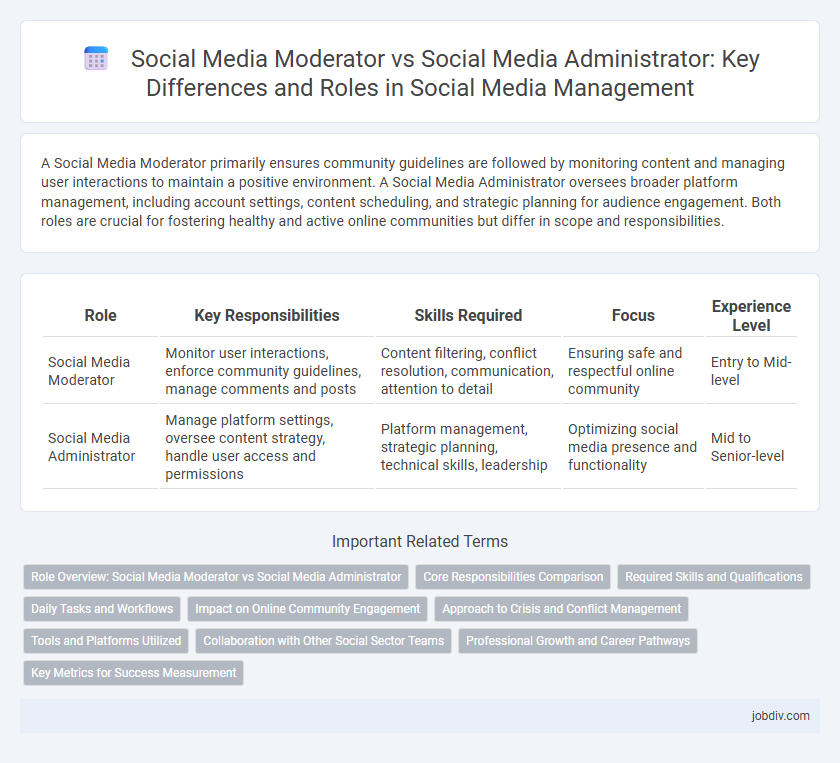A Social Media Moderator primarily ensures community guidelines are followed by monitoring content and managing user interactions to maintain a positive environment. A Social Media Administrator oversees broader platform management, including account settings, content scheduling, and strategic planning for audience engagement. Both roles are crucial for fostering healthy and active online communities but differ in scope and responsibilities.
Table of Comparison
| Role | Key Responsibilities | Skills Required | Focus | Experience Level |
|---|---|---|---|---|
| Social Media Moderator | Monitor user interactions, enforce community guidelines, manage comments and posts | Content filtering, conflict resolution, communication, attention to detail | Ensuring safe and respectful online community | Entry to Mid-level |
| Social Media Administrator | Manage platform settings, oversee content strategy, handle user access and permissions | Platform management, strategic planning, technical skills, leadership | Optimizing social media presence and functionality | Mid to Senior-level |
Role Overview: Social Media Moderator vs Social Media Administrator
Social Media Moderators primarily focus on monitoring user interactions, enforcing community guidelines, and managing comments to maintain a positive online environment. Social Media Administrators oversee broader platform management tasks, including content strategy, user account control, and analytics reporting to optimize overall social media presence. Both roles require strong communication skills but differ in scope, with moderators handling day-to-day user engagement and administrators managing strategic and operational functionalities.
Core Responsibilities Comparison
Social Media Moderators primarily focus on monitoring user interactions, enforcing community guidelines, and managing content to maintain a positive online environment. Social Media Administrators handle broader responsibilities including account setup, strategy implementation, performance analysis, and overall platform management. While moderators ensure compliance and user safety, administrators drive engagement growth and oversee campaign execution.
Required Skills and Qualifications
Social Media Moderators must excel in content filtering, community management, and conflict resolution, often requiring proficiency in platform-specific tools and basic data analysis. Social Media Administrators need advanced skills in strategic planning, analytics, and campaign management, with qualifications frequently including certifications in digital marketing and expertise in social media management software. Both roles demand strong communication skills, but administrators typically require deeper technical knowledge and leadership capabilities to drive social media initiatives.
Daily Tasks and Workflows
Social Media Moderators primarily focus on monitoring user-generated content, enforcing community guidelines, and responding to comments or messages to maintain a positive online environment. Social Media Administrators oversee broader platform management tasks, including content scheduling, account strategy implementation, and performance analytics reporting. Both roles require collaboration with content creators and marketing teams, but moderators have a more reactive daily workflow, while administrators engage in proactive planning and analysis.
Impact on Online Community Engagement
Social Media Moderators directly influence online community engagement by managing interactions, enforcing community guidelines, and promptly addressing conflicts, which fosters a safe and inclusive environment. Social Media Administrators impact engagement through strategic content planning, analytics monitoring, and platform optimization, driving sustained community growth and active participation. Both roles are crucial; moderators maintain the quality of interactions, while administrators shape the overall community experience and engagement strategies.
Approach to Crisis and Conflict Management
Social Media Moderators implement real-time monitoring and immediate response strategies to de-escalate conflicts and remove harmful content, ensuring community guidelines are upheld. Social Media Administrators develop comprehensive crisis management protocols and coordinate cross-departmental efforts to address larger-scale issues and reputation risks. Both roles prioritize proactive communication but differ in scope, with moderators handling day-to-day conflicts and administrators focusing on strategic oversight and long-term crisis resolution.
Tools and Platforms Utilized
Social Media Moderators primarily use community management tools like Hootsuite, Sprout Social, and Brandwatch to monitor user interactions, enforce guidelines, and manage comments across platforms such as Facebook, Twitter, and Instagram. Social Media Administrators rely on content management systems (CMS) like WordPress, platform-specific admin dashboards, and analytics tools such as Google Analytics and Facebook Insights to strategize content, schedule posts, and analyze performance. Both roles utilize collaboration tools like Slack or Trello to coordinate with marketing teams and ensure cohesive brand messaging across digital channels.
Collaboration with Other Social Sector Teams
Social Media Moderators primarily collaborate with community managers, content creators, and support teams to ensure timely responses to user inquiries and maintain a positive online environment. Social Media Administrators work closely with marketing, public relations, and analytics departments to strategize content distribution, monitor campaign performance, and align social media initiatives with broader organizational goals. Both roles require seamless communication and coordination within social sector teams to enhance brand reputation and engage target audiences effectively.
Professional Growth and Career Pathways
Social Media Moderators hone skills in content management, conflict resolution, and community engagement, creating a foundation for advancing into roles such as Social Media Administrator or Community Manager. Social Media Administrators oversee broader strategic aspects, including analytics, campaign implementation, and team coordination, offering clearer pathways to senior positions like Social Media Director or Digital Marketing Manager. Both roles provide essential experience and professional growth opportunities within the dynamic social media industry.
Key Metrics for Success Measurement
Social Media Moderators focus on engagement metrics such as comment sentiment, response time, and user-generated content quality to ensure community guidelines are enforced and conversations remain positive. Social Media Administrators prioritize broader performance indicators like follower growth rate, reach, click-through rates, and overall campaign effectiveness to align social strategies with business goals. Both roles utilize analytics platforms including Hootsuite, Sprout Social, and native tools like Facebook Insights to track these key performance metrics consistently.
Social Media Moderator vs Social Media Administrator Infographic

 jobdiv.com
jobdiv.com